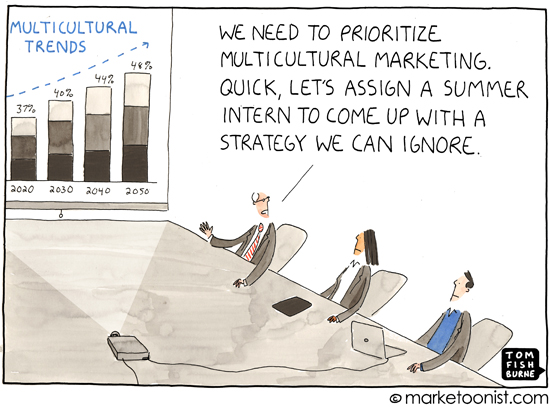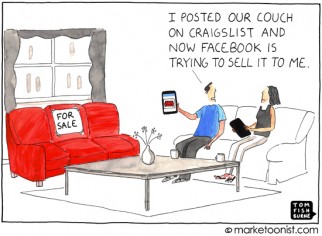Walmart projects that 100% of its sales growth will come from multicultural customers. They are doubling their multicultural advertising spend.
Marketers can’t ignore the demographic trends. In the US, 93% of population growth is multicultural, nearing 40% of the population, and one in four babies born is Hispanic. To grow, marketers clearly need a strategy to drive penetration with multicultural consumers.
Yet in many organizations, multicultural marketing is an after-thought. It is managed as a silo, given lip service, or handed off to summer interns. Despite the statistics, organizations can be reluctant to invest in multicultural marketing because ROI is low and because marketers think they’re reaching these audiences in their general marketing plans.
Walmart is doubling down on multicultural marketing. One of the main shifts is making multicultural part of everything they do, rather than projects in silos.
Walmart’s Tony Rogers described three levels of multicultural marketing:
“The first level of ‘getting it’ is not doing anything. The second level is recognizing its importance, but keeping efforts pretty siloed, like spending some money during Black History Month and Hispanic Heritage Month and considering the multicultural box to be ticked off. The next step is where we are — making multicultural part of everything we do.”
I would love to hear any great examples, misfires, or missed opportunities of multicultural marketing. Many thanks to my old friend and mentor Helen Kurtz for suggesting this topic.
(Marketoonist Monday: I’m giving away a signed print of this week’s cartoon. Just share an insightful comment to this week’s post by 5:00 PST on Monday. Thanks!)



Ori Pomerantz says
I think calling it “multicultural marketing” is the first mistake. You don’t market to a vague “multicultural” group. You market to concrete people, who are culturally Hispanic, Ghetto(1), Vietnamese, etc.
There is no good reason to assume those groups are similar.
(1) This term may be offensive, but I find it more credible that poor urbanites are a separate group from middle class suburbanites than that it is a matter of skin color.
Suresh Shah says
I feel more comfortable with Asian and Western. It’s broad grouping really is helpful in strategy and implementation. Asian culture though diverse, runs on a common thread. Same is true of Western – whether US or European.
Karen Montemayor says
Then why not just use the term “poor urbanites”?
Lily says
Marketing professionals should be the first to recognize that multicultural or ethnic marketing is passe. We live in a multicultural society. Multicultural is General Market. What is more accurate for Walmart is that their spend is shifting from General Market to Target Market Segments.
T. Watson says
Would not a customer persona based on lifestyle and buying habits be more accurate (and cross-cultural) than a classification of skin color? Ethnicity would be a part of the persona, but not the driving factor. HOW a person lives and works is a stronger indication of what they will be interested in or ultimately purchase.
Daniel Rosas Ocejo says
The Walmart model has potential when marketing is centralized & a leader that is dedicated to it can review all plans to ensure that Multicultural is included in an organic way (i.e: based on key insights that are relevant to the brand/product and not just by seeing that a quota has been reached). But when you have marketing being managed in separate business units the quality control/compliance is more difficult. Further not all brands/product resonate at the same level within Multicultural segments so it is important to realize that not every product in a portfolio will (or should) have the same level of investment. Additionally, when you throw in the dizzying array of background and countries-of-origin what used to be a rather large opportunity becomes diluted to practically nothing. Alas, many organization find themselves on this slippery slope as they either go too narrow in target selection or too broad. Either extreme causing zero to no ROI.
There is also regionalization. Some brands/products may perform better in some markets then in others due to the background of a specific group (i.e: Cubans vs. Mexicans or African-Americans in Detroit versus in Houston) which lends itself to creating plans & executing at a local level rather then a national platform.
Another key point that further complicates the approach to Multicultural is that the entire leadership has to be bought in across functions by having measurable metrics included in performance evaluations. Further, Multicultural marketing should’t solely be the responsibility of marketing but rather the focus of each individual that touches a brand from sales, to finance to research. That is where the Walmart model has the potential to fall apart.
And lastly you have the agencies. Do we go with a “General Market” agency that has people that know Multicultural or do we go with a “Multicultural” agency that should have the knowledge but lacks the depth that a bigger firm may have? Adding on to that is if a company already has “consultants” internally that support the brand teams then there is the high potential for confusion between them, the brands and the agency. Who makes the final call? Who do the brands ultimately listen to? Who owns the funds for dedicated Multicultural marketing?
Alas, Tony Rogers may be right that acknowledging you have a problem is the first step. What to do from there is can have many different endings.
-Daniel AE
pd: sorry I went long long this note. Just this topic has many layers. Huge fan of your work!
Carolina says
This is so sad but true. It definately take courageous Brand Managers to make a change. If often comes down to the leader having afinity for the latin market, consumer or previous experience outside the US to take this on seriously. If planning for ethnic consumers is not part of the daily brand operations it will never work. It will always make it to the chopping list. Furthermore, new consumers and younger consumer are multi-cultural in nature. So disregarding this consumers now is disregarding future sales.
Jennifer S Nelson says
Right on, as usual Tom. Let me build on one point:
Yet in many organizations, multicultural marketing is an after-thought. It is managed as a silo, given lip service, handed off to summer interns…
OR written into annual business plans, only to have it’s funding (and thus execution) cut before that year’s brand plan even gets underway. Sad but true at most companies, no?
What I really wish for, for all marketers: is the willingness to REALLY step out of ones own shoes and understand the world view, consumption behaviors, habits, unmet needs and so on, of ANY of their best growth prospects… embracing, but also moving beyond ethnicity as a key variable.
Shawn T. says
Multicultural is Gen Pop except in the case of Lationos that can’t speak English. They have very different tastes and habits. So does urban black culture. I mean they do things differently at every level, including food, music, clothes, politics etc. The fact is that each budget should not silo “multi-cultural” in a silo but instead every decision should be strategic for which segment is appeals to. As much as you think this is amelting pot, there are still distinct differences between cultures and ethnicities.
mahta e says
Isn’t multicultural the new GP? Both the marketplace and consumers have changed drastically – not just demographically but also culturally (needs, values, and attitudes). We live in a global market; everyone is connected and brands and their actions ripple beyond their immediate geography. And are either amplified or challenged by consumers themselves (thanks to social media and accessibility of technology).
I may be naive but it seems to me that to be multicultural, you need to be culturally open as a brand and as an organization. Don’t create an ad in Spanish language or use ethnically specific actors to connect with a specific group. That is not being multicultural. It is about the shared values and emerging behaviors that are the result of this integrative world.
tomfishburne says
Hi all,
Really insightful perspective, many thanks! This week’s winner is Daniel.
-Tom
Lalo Wakefield says
Having been in the Hispanic Marketing industry for more than 20 years, I could not agree more with T Watson and Jennifer. In not one focus group of the hundreds in which I participated, did I ever hear a hispanic subject say, “today, I want to be a better Hispanic”. But many did express that they wanted to be better fathers, carpinters, businessmen, cooks, etc., who happened to be Hispanics. Their lifestyles, aspirations and buying habits/needs are much more important than their hispanicity to them, why should it be any different to the brands that are trying to reach them. Yes, there are very important cultural differences which must be accounted for, but my advice is not to place those nuances at the core of your marketing strategies. Hispanic agencies have shot themselves in the foot trying to justify their existence by pushing for the hispanic first, consumer next approach, thus making creativity contrived and stereotypical.
Thank goodness for digital channels and fully bilingual and bicultural Hispanics. Because of them mediocrity in the Hispanic Marketing industry is slowly slipping into the past. Now, as Jennifer says, if Brand Managers and CMOs would stop treating it as an after thought and truly embrace it for what it is, a vibrant, industrious and diverse community, everyone would reap the benefits of the guacamole action.
Stoan says
Ultimately, this sort of generalisation is a mark of marketers closeting themselves in their offices or at conferences and (often) refusing or not knowing how to get to understand the nuances that make up their different target audiences. If they could do this, communications would focus on attitudes to a category and be truly cross-cultural without appearing to try to hoodwink one target segment to the detriment of engagements with other racial/ethnic segments.
Mike M says
If corporations look at multicultural globally, than marketing budgets allocated for Asia, South America, Africa or any other country, should include a budget line for those ethnic groups in the United States. If its domestic only, they should only look at ethnic marketing with the intention of looking globally.
Sucess is McDonalds. They market in all counties and U.S. ethnic. As well as promote unity in general market advertising.